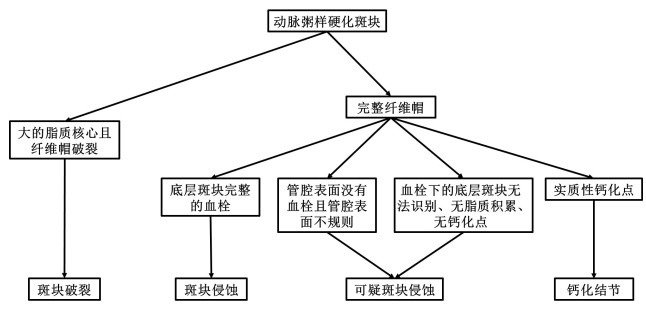Imaging advances in the diagnosis of plaque erosion in patients with acute coronary syndromes
-
摘要: 斑块侵蚀是急性冠脉综合征的重要发病机制之一。针对斑块侵蚀的急性冠脉综合征患者,抗栓治疗而非支架治疗是其更为安全有效的治疗选择,因此临床上斑块侵蚀的准确识别至关重要。技术的发展极大地推进了斑块侵蚀的诊断进展,本文从人体尸检研究的重要发现、光学相干断层扫描、血管内超声、近红外光谱、冠状动脉计算机断层扫描血管造影、生物标志物几个方面展开,就上述诊断手段进行回顾与总结。Abstract: Plaque erosion is one of the important pathogenesis of acute coronary syndrome. For patients with acute coronary syndrome with plaque erosion, antithrombotic therapy rather than stent implantation is a safer and more effective treatment option, so the accurate clinical identification of plaque erosion in clinic is quite critical. The development of technology has greatly advanced the diagnosis of plaque erosion. This article reviews and summarizes the diagnostic methods from the human autopsy studies, optical coherence tomography, intravascular ultrasound, near-infrared spectroscopy, coronary computed tomography angiography, and biomarkers.
-
表 1 不同诊断手段的特点对比
Table 1. Comparison of the characteristics of different diagnostic methods
诊断手段 优点 缺点 OCT 分辨率高(10~15 μm),直接准确识别斑块类型;对斑块微观结构提供更多信息,包括纤维帽、微血管、血栓、炎症细胞和胆固醇结晶等[6, 19] 基于导管的侵入式成像方式;无法显示内皮细胞的损伤;易受叠加血栓影响[19, 23] IVUS 较OCT更为简易;对斑块分布和形态进行纵向和横截面的实时评估[25]; 识别易损斑块和高风险个体;指导个体化介入治疗选择 基于导管的侵入式成像方式低分辨率(100~200 μm),无法准确识别薄纤维帽(< 65 μm)[6, 26] NIRS 检测脂质成分,量化脂质积累;通过评估冠状动脉钙化点、斑块空腔和maxLCBI4mm判别斑块类型;具有预测ACS患者预后的价值[35, 37] 基于导管的侵入式成像方式; 需要结合IVUS使用,量化复杂 CCTA 无创操作;以非侵入性方式对所有主要冠脉及其分支的斑块负荷进行全局评估[40];识别高风险个体;方便重复呈现以观察斑块进展或预测斑块预后 低分辨率(0.5 mm),无法直接识别纤维帽和脂质核心[39-40] OCT: 光学相干断层扫描; IVUS: 血管内超声; NIRS: 近红外光谱; CCTA: 冠状动脉计算机断层扫描血管造影. -
[1] Members WG, Mozaffarian D, Benjamin EJ, et al. Heart disease and stroke statistics-2016 update: a report from the American heart association[J]. Circulation, 2016, 133(4): e38-e60. [2] Mensah GA, Roth GA, Fuster V. The global burden of cardiovascular diseases and risk factors: 2020 and beyond[J]. J Am Coll Cardiol, 2019, 74(20): 2529-32. doi: 10.1016/j.jacc.2019.10.009 [3] van der Wal AC, Becker AE, van der Loos CM, et al. Site of intimal rupture or erosion of thrombosed coronary atherosclerotic plaques is characterized by an inflammatory process irrespective of the dominant plaque morphology[J]. Circulation, 1994, 89(1): 36-44. doi: 10.1161/01.CIR.89.1.36 [4] Farb A, Burke AP, Tang AL, et al. Coronary plaque erosion without rupture into a lipid core. A frequent cause of coronary thrombosis in sudden coronary death[J]. Circulation, 1996, 93(7): 1354-63. doi: 10.1161/01.CIR.93.7.1354 [5] Jang IK, Bouma BE, Kang DH, et al. Visualization of coronary atherosclerotic plaques in patients using optical coherence tomography: comparison with intravascular ultrasound[J]. J Am Coll Cardiol, 2002, 39(4): 604-9. doi: 10.1016/S0735-1097(01)01799-5 [6] Jang IK, Tearney GJ, MacNeill B, et al. In vivo characterization of coronary atherosclerotic plaque by use of optical coherence tomography[J]. Circulation, 2005, 111(12): 1551-5. doi: 10.1161/01.CIR.0000159354.43778.69 [7] Kubo T, Imanishi T, Takarada S, et al. Assessment of culprit lesion morphology in acute myocardial infarction: ability of optical coherence tomography compared with intravascular ultrasound and coronary angioscopy[J]. J Am Coll Cardiol, 2007, 50(10): 933-9. doi: 10.1016/j.jacc.2007.04.082 [8] Jia HB, Abtahian F, Aguirre AD, et al. In vivo diagnosis of plaque erosion and calcified nodule in patients with acute coronary syndrome by intravascular optical coherence tomography[J]. J Am Coll Cardiol, 2013, 62(19): 1748-58. doi: 10.1016/j.jacc.2013.05.071 [9] Yin YW, Fang C, Jiang SQ, et al. In vivo evidence of atherosclerotic plaque erosion and healing in patients with acute coronary syndrome using serial optical coherence tomography imaging[J]. Am Heart J, 2022, 243: 66-76. doi: 10.1016/j.ahj.2021.09.007 [10] Kolte D, Yonetsu T, Ye JC, et al. Optical coherence tomography of plaque erosion: JACC focus seminar part 2/3[J]. J Am Coll Cardiol, 2021, 78(12): 1266-74. doi: 10.1016/j.jacc.2021.07.030 [11] Jia HB, Dai JN, Hou JB, et al. Effective anti-thrombotic therapy without stenting: intravascular optical coherence tomographybased management in plaque erosion (the EROSION study)[J]. Eur Heart J, 2017, 38(11): 792-800. [12] Lindstedt KA, Kovanen PT. Mast cells in vulnerable coronary plaques: potential mechanisms linking mast cell activation to plaque erosion and rupture[J]. Curr Opin Lipidol, 2004, 15(5): 567-73. doi: 10.1097/00041433-200410000-00011 [13] Burke AP, Farb A, Malcom GT, et al. Coronary risk factors and plaque morphology in men with coronary disease who died suddenly[J]. N Engl J Med, 1997, 336(18): 1276-82. doi: 10.1056/NEJM199705013361802 [14] Arbustini E, dal Bello B, Morbini P, et al. Plaque erosion is a major substrate for coronary thrombosis in acute myocardial infarction [J]. Heart, 1999, 82(3): 269-72. doi: 10.1136/hrt.82.3.269 [15] Burke AP, Farb A, Malcom GT, et al. Effect of risk factors on the mechanism of acute thrombosis and sudden coronary death in women[J]. Circulation, 1998, 97(21): 2110-6. doi: 10.1161/01.CIR.97.21.2110 [16] Huynh K. Inflammation in plaque erosion and rupture[J]. Nat Rev Cardiol, 2022, 19(2): 80. [17] Puri RS, Worthley MI, Nicholls SJ. Intravascular imaging of vulnerable coronary plaque: current and future concepts[J]. Nat Rev Cardiol, 2011, 8(3): 131-9. doi: 10.1038/nrcardio.2010.210 [18] Kubo T, Akasaka T. Recent advances in intracoronary imaging techniques: focus on optical coherence tomography[J]. Expert Rev Med Devices, 2008, 5(6): 691-7. doi: 10.1586/17434440.5.6.691 [19] Partida RA, Libby P, Crea F, et al. Plaque erosion: a new in vivo diagnosis and a potential major shift in the management of patients with acute coronary syndromes[J]. Eur Heart J, 2018, 39(22): 2070-6. doi: 10.1093/eurheartj/ehx786 [20] Fang C, Lu J, Zhang ST, et al. Morphological characteristics of eroded plaques with noncritical coronary Stenosis: an optical coherence tomography study[J]. J Atheroscler Thromb, 2022, 29 (1): 126-40. doi: 10.5551/jat.60301 [21] Jia HB, Abtahian F, Aguirre AD, et al. In vivo diagnosis of plaque erosion and calcified nodule in patients with acute coronary syndrome by intravascular optical coherence tomography[J]. J Am Coll Cardiol, 2013, 62(19): 1748-58. doi: 10.1016/j.jacc.2013.05.071 [22] Kato A, Minami Y, Asakura K, et al. Characteristics of carotid atherosclerosis in patients with plaque erosion[J]. J Thromb Thrombolysis, 2021, 52(2): 620-7. doi: 10.1007/s11239-021-02419-1 [23] Sathyamurthy I, Sengottuvelu G. Can OCT change the therapeutic strategy in ACS due to plaque erosion?[J]. Indian Heart J, 2021, 73 (3): 259-63. doi: 10.1016/j.ihj.2021.04.003 [24] Terada K, Kubo T, Kameyama T, et al. NIRS-IVUS for differentiating coronary plaque rupture, erosion, and calcified nodule in acute myocardial infarction[J]. JACC Cardiovasc Imaging, 2021, 14(7): 1440-50. doi: 10.1016/j.jcmg.2020.08.030 [25] Papaioannou TG, Kalantzis C, Katsianos E, et al. Personalized assessment of the coronary atherosclerotic arteries by intravascular ultrasound imaging: hunting the vulnerable plaque[J]. J Pers Med, 2019, 9(1): 8. doi: 10.3390/jpm9010008 [26] Fahed AC, Jang IK. Plaque erosion and acute coronary syndromes: phenotype, molecular characteristics and future directions[J]. Nat Rev Cardiol, 2021, 18(10): 724-34. doi: 10.1038/s41569-021-00542-3 [27] Mintz GS, Nissen SE, Anderson WD, et al. American college of cardiology clinical expert consensus document on standards for acquisition, measurement and reporting of intravascular ultrasound studies (IVUS)[J]. J Am Coll Cardiol, 2001, 37(5): 1478-92. doi: 10.1016/S0735-1097(01)01175-5 [28] Wu XF, Mintz GS, Xu K, et al. The relationship between attenuated plaque identified by intravascular ultrasound and no-reflow after stenting in acute myocardial infarction: the HORIZONS-AMI (Harmonizing Outcomes With Revascularization and Stents in Acute Myocardial Infarction) trial[J]. JACC Cardiovasc Interv, 2011, 4(5): 495-502. doi: 10.1016/j.jcin.2010.12.012 [29] Mintz GS, Douek P, Pichard AD, et al. Target lesion calcification in coronary artery disease: an intravascular ultrasound study[J]. J Am Coll Cardiol, 1992, 20(5): 1149-55. doi: 10.1016/0735-1097(92)90371-S [30] Tuzcu EM, Berkalp B, de Franco AC, et al. The dilemma of diagnosing coronary calcification: angiography versus intravascular ultrasound[J]. J Am Coll Cardiol, 1996, 27(4): 832-8. doi: 10.1016/0735-1097(95)00537-4 [31] Yonetsu T, Jang IK. Advances in intravascular imaging: new insights into the vulnerable plaque from imaging studies[J]. Korean Circ J, 2018, 48(1): 1-15. doi: 10.4070/kcj.2017.0182 [32] Hong SJ, Kim BK, Shin DH, et al. Effect of intravascular ultrasound-guided vs angiography-guided everolimus-eluting stent implantation: the IVUS-XPL randomized clinical trial[J]. J Am Med Assoc, 2015, 314(20): 2155-63. doi: 10.1001/jama.2015.15454 [33] Zhang JJ, Gao XF, Kan J, et al. Intravascular ultrasound versus angiography-guided drug-eluting stent implantation: the ULTIMATE trial[J]. J Am Coll Cardiol, 2018, 72(24): 3126-37. doi: 10.1016/j.jacc.2018.09.013 [34] Motz JT, Fitzmaurice M, Miller A, et al. In vivo Raman spectral pathology of human atherosclerosis and vulnerable plaque[J]. J Biomed Opt, 2006, 11(2): 9-10. http://www.onacademic.com/detail/journal_1000037708492310_f244.html [35] Gardner CM, Tan HW, Hull EL, et al. Detection of lipid core coronary plaques in autopsy specimens with a novel catheter-based near-infrared spectroscopy system[J]. JACC Cardiovasc Imaging, 2008, 1(5): 638-48. doi: 10.1016/j.jcmg.2008.06.001 [36] Puri RS, Madder RD, Madden SP, et al. Near-infrared spectroscopy enhances intravascular ultrasound assessment of vulnerable coronary plaque: a combined pathological and in vivo study[J]. Arterioscler Thromb Vasc Biol, 2015, 35(11): 2423-31. doi: 10.1161/ATVBAHA.115.306118 [37] Kubo T, Terada K, Ino Y, et al. Combined use of multiple intravascular imaging techniques in acute coronary syndrome[J]. Front Cardiovasc Med, 2022, 8: 824128. doi: 10.3389/fcvm.2021.824128 [38] Schuurman AS, Vroegindewey M, Kardys I, et al. Near-infrared spectroscopy-derived lipid core burden index predicts adverse cardiovascular outcome in patients with coronary artery disease during long-term follow-up[J]. Eur Heart J, 2017, 39(4): 295-302. [39] Collet C, Conte E, Mushtaq S, et al. Reviewing imaging modalities for the assessment of plaque erosion[J]. Atherosclerosis, 2021, 318: 52-9. doi: 10.1016/j.atherosclerosis.2020.10.017 [40] de Feijter PJ, Nieman K. Failure of CT coronary imaging to identify plaque erosion: a resetting of expectations[J]. Eur Heart J, 2011, 32(22): 2736-8. doi: 10.1093/eurheartj/ehr201 [41] van den Hoogen IJ, Gianni U, Al Hussein Alawamlh O, et al. What atherosclerosis findings can CT see in sudden coronary death: plaque rupture versus plaque erosion[J]. J Cardiovasc Comput Tomogr, 2020, 14(3): 214-8. doi: 10.1016/j.jcct.2019.07.005 [42] Ozaki Y, Okumura M, Ismail TF, et al. Coronary CT angiographic characteristics of culprit lesions in acute coronary syndromes not related to plaque rupture as defined by optical coherence tomography and angioscopy[J]. Eur Heart J, 2011, 32(22): 2814-23. doi: 10.1093/eurheartj/ehr189 [43] Opolski MP, Debski A, Petryka J, et al. CT for prediction of plaque erosion resulting in myocardial infarction with non-obstructive coronary arteries[J]. J Cardiovasc Comput Tomogr, 2017, 11(3): 237-9. doi: 10.1016/j.jcct.2017.02.009 [44] Nakajima A, Sugiyama T, Araki M, et al. Plaque rupture, compared with plaque erosion, is associated with a higher level of pancoronary inflammation[J]. JACC Cardiovasc Imaging, 2021: 2021, 11: S1936-878X(21)00781-6. [45] Franck G, Mawson T, Sausen G, et al. Flow perturbation mediates neutrophil recruitment and potentiates endothelial injury via TLR2 in mice: implications for superficial erosion[J]. Circ Res, 2017, 121(1): 31-42. doi: 10.1161/CIRCRESAHA.117.310694 [46] Li JN, Tan Y, Sheng ZX, et al. The association between plasma hyaluronan level and plaque types in ST-segment-elevation myocardial infarction patients[J]. Front Cardiovasc Med, 2021, 8: 628529. doi: 10.3389/fcvm.2021.628529 [47] Wang Y, Zhao XX, Zhou P, et al. Plasma pentraxin-3 combined with plaque characteristics predict cardiovascular risk in ST-segment elevated myocardial infarction: an optical coherence tomography study[J]. J Inflamm Res, 2021, 14: 4409-19. doi: 10.2147/JIR.S330600 [48] Zhao XX, Song L, Wang Y, et al. Proprotein convertase subtilisin/ kexin type 9 and systemic inflammatory biomarker pentraxin 3 for risk stratification among STEMI patients undergoing primary PCI [J]. J Inflamm Res, 2021, 14: 5319-35. doi: 10.2147/JIR.S334246 -







 下载:
下载:


